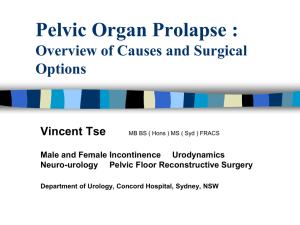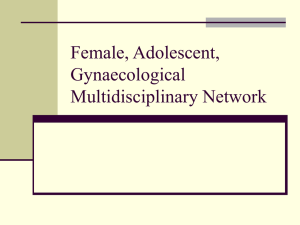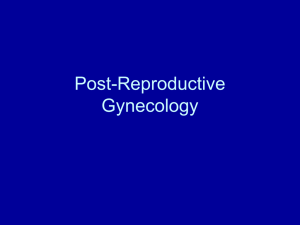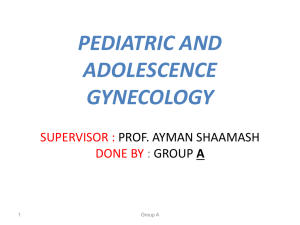The New Age of Pessaries
advertisement
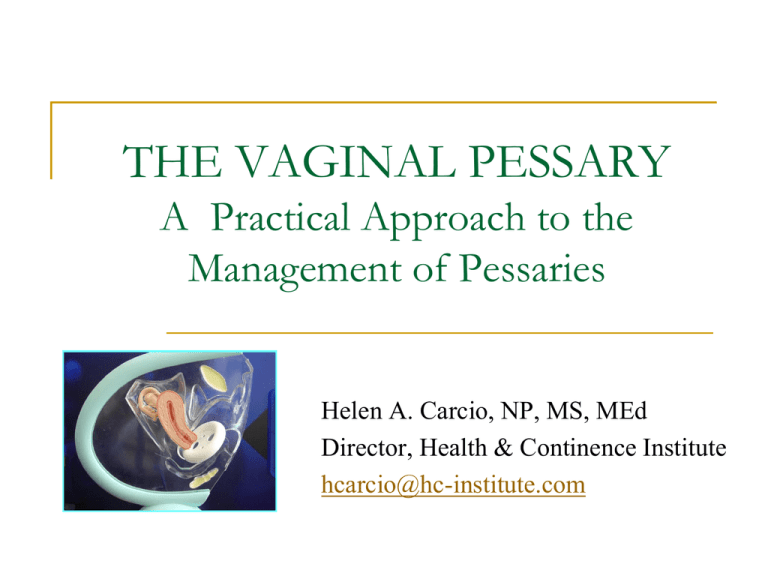
THE VAGINAL PESSARY A Practical Approach to the Management of Pessaries Helen A. Carcio, NP, MS, MEd Director, Health & Continence Institute hcarcio@hc-institute.com THE VAGINAL PESSARY A Thing of Beauty! WHY CONSIDER THE PESSARY? Demand for treatment of POP or UI is projected to grow by 45% in the next 30 years Viable alternative to new “high tech” surgeries Very effective, low-risk of complications Equally beneficial for both POP or UI Satisfaction rate is high – 72-92% report symptom relief Prevents problems that occur if left untreated Loss of women from the work force Increased use of incontinence products Increased admission to assisted care facilities Emotional toll PURPOSES Supports the vaginal musculature/bladder base in physiologic alignment Can provide a permanent solution to incontinence in women unable or unwilling to have surgical correction May improve a prolapse or prevent one from worsening May uncover the presence of any hidden incontinence related to a marked cystocele Provides a diagnostic means of predicting which patients would be helped with surgical correction ADVANTAGES Uro-gynecology Reduces the symptoms of incontinence Supports and corrects retro-displacement of the uterus in early pregnancy Relieves the discomfort of a pelvic organ prolapse Pelvic Floor Rehabilitation Repositions pelvic structures during pelvic floor rehabilitation Promotes muscle re-education & strengthening PESSARY CAN SUPPORT A POP A. Cystocele B. Rectocele C. Enterocele CAUSES OF PROLAPSE Constipation Exercise Pregnancy and Childbirth Abnormal collagen/connective tissue Hormonal factors Previous pelvic surgery NOTE: The pessary works very well but some behavior modification to decrease causes is also essential. STRESS INCONTINECE: Causes Weakened pelvic floor musculature Intrinsic sphincter deficiency Increased intraabdominal pressure Reduced strength of urethral sphincter NOTE: The pessary ring with knob increases the closing pressure of the urethra URGE INCONTINENCE: Causes Overactive bladder Detrusor hyperreflexia Cystocele Note: Pessary works very well to lift and support a cystocele to allow the bladder to empty more completely WHY WOMEN WON’T DISCUSS Consider incontinence or prolapse a normal part of aging Fear it is associated with some sort of cancer Fear institutionalization Are able to rely on self-management regimes Feel associated shame and embarrassment PCP’s fail to inquire about it Are unaware of conservative treatments (pessary) Have had a friend/relative with a pessary and do not want to be “old like her” MULTIFACETED APPROACH The pessary works very well to relieve symptoms related to incontinence and POP Pelvic floor rehabilitation helps stabilize musculature around pessary Behavior modification helps reduce episodes of urgency, frequency, and incontinence Medications help reduce bladder contractions and nourish the vaginal mucosa Combination strategies result in a dramatic improvement in symptoms HISTORICAL PERSPECTIVES Appears in both Latin and Greek literature Many different types of materials and shapes Over 2000 used throughout history Fell into disfavor 1020 years ago Today offers a viable alternative to surgery PESSARY FEATURES Silicone – FDA approved Non-toxic, medical-grade silicone Biologically inert - does not absorb vaginal odor Pliable Can be autoclaved or soaked in Cidex A few pessaries are made of latex rubber Must assess and document any latex allergy Available in a variety of sizes and shapes The outside diameter is measured in inches with a range of one to four inches CONSIDERATIONS PRIOR Possibility of other gynecological care and procedures Ability of the woman to manage the pessary Extent of sexual activity Sexual activity GYN care Women’s dexterity SEXUAL ACTIVITY Intercourse is possible with pessaries that are not vaginally occlusive Must have the dexterity and know-how to insert and remove as necessary Note: Always ask about sexual activity – never assume CONTRAINDICATIONS Severe untreated vaginal atrophism Vaginal bleeding of unknown origin Pelvic inflammatory disease Abnormal pap smear Dementia without possibility of dependable follow-up care Expected non-compliance with follow-up EMOTIONAL BARRIER May initially view the pessary as a “foreign object” which they want no part of Must begin the “comfort” process Allow to handle the pessary Talk to other women who have one Need to understand the proper care Explain that the properly fitted pessary should not be felt It will soon become their “best friend” THE LEARNING CURVE Insertion technique requires patience and practice May initially feel insecure about which types to use since there are so many to choose from There are a variety of pessaries that could work for any given condition; on the other hand……… There are a variety of conditions where a pessary will not fit correctly or correct the problem Use should progress from the simple to the complex The majority of urogynecologists use the ring with support and knob THE EVALUATION Pelvic Examination Determine the extent of the pelvic support problem Assess degree of incontinence Simple CMG Rule out any pathology Pap smear Wet mount Assess estrogen status Wet mount Vaginal pH PELVIC ORGAN PROLAPSE QUANTIFICATION EXAM Measures the descent of the anterior, apical and/or posterior portions of the vagina Records vaginal length and width of the introitus. Uses centimeters with reference to the hymen when performing the Valsalva Negative numbers: Distance above the hymen Positive numbers: Distance of prolpase protruding beyond hymen May simply grade the prolapse from 1 to 3 PATIENT PREPARATION Advise woman to arrive with her rectum as empty as possible Have her void immediately prior to fitting Reinforce the “trial & error” nature of pessary fitting Allow woman to examine and hold pessary prior to insertion The fitting process itself maybe a little uncomfortable SOME THOUGHTS No need to recreate pelvic anatomy…want to just keep inside Don’t memorize which pessary to use with which condition; start with the simple ring Some possible predictors of pessary failure Short vaginal length Wide introitus Posterior-wall defects Patients who desire surgery SUPPORT PESSARIES Start with a trial of a support pessary Most women will do well with the ring with knob. Additionally, the membrane will support any prolapse The next few slides will show the insertion and removal technique using the ring since it would be impossible to outline all the pessaries THE RING with KNOB Often referred to as the “incontinence ring” since it works so well for stress incontinence Available with membrane to support prolapse Has holes for drainage Knob applies pressure to the urethra against the pubic bone Very easy to insert and remove SPACE FILLING PESSARIES If unsuccessful, progress to space-filling pessaries (donut, cube) More difficult to insert and remove Usually require provider assistance for cleaning May have to be removed more often due to drainage issues Work well in women who have both a cystocele and rectocele THE FITTING – “TRIAL & ERROR” There are many different sizes and shapes of pessaries to fit the many different sizes and shapes of a woman’s vagina The examiner should become comfortable with a single pessary and then progress to others Must educate the woman that it may take a series of visits to ensure an adequate fit Pessary should be large enough for its designed function but small enough to prevent any discomfort LUBRICATION Avoid lubricating the pessary itself Mix Xylocaine gel (50-50) with lubricant Generously lubricate the vaginal introitus with non-dominant hand Grasp pessary with the non-lubricated hand in order to keep a firm hold As an alternative may lubricate the leading edge of the pessary FITTING A PESSARY The pubic bone is an important landmark. The pessary should fit snugly behind it. There is less chance of expulsion if thus anchored Uterine Prolapse (if present) Insert two fingers in the vagina to push any uterine prolapse back into place Place opposite hand on abdomen and push on the fundus (if present) to hold in place Reduce any cystocele or rectocele prior to fitting Put in largest size that will fit comfortably, or simply tuck a smaller pessary well behind the pubic bone TEST PRIOR TO FITTING Insert two fingers into the vagina Extend fingers to either side of the vaginal fornices Keep fingers extended and pull through introitus If you must close your fingers to get them out a pessary will probably be retained MEASURING THE WIDTH Insert first two fingers of dominant hand deep to the posterior fornix Approximate size by using the fingers to determine the width Spread fingers wide to measure Remove fingers and compare to pessary sample or fitting kit FITTING KIT Bioteque Fitting Kit Attractive package Contains 6 rings Approximates proper fit Useful for fitting most round pessaries Actual fit will vary with the type of pessary inserted MEASURING THE LENGTH Reinsert fingers deep into the posterior fornix Make note of where the hand comes into contact with the pubic bone Compare to pessary. I d e n INSERTION TECHNIQUE Remove and compare width to pessary sample Fold the chosen pessary at the notches with concavity facing downward Separate the labia minor posteriorly at the introitus with the non-dominant hand Hold folded pessary firmly and insert through the introitus by curving it posteriorly INSERTION TECHNIQUE Slide it into the vagina, and curve posteriorly Release and allow to spring open to its normal shape Push deep into the vaginal vault Tuck securely behind pubic bone anteriorly and under the cervix (if present) posteriorly INSERTION Should be able to sweep the tip of one finger around the pessary Insert a finger tip into one of the larger holes and rotate the pessary until the knob is behind the pubic bone, at the level of the urethra This helps to stabilize the urethrovesicular junction Assess comfort FITTING – SOME THOUGHTS Can be tricky – want to fit with the smallest pessary that can be easily inserted but can also come out with the least amount of difficulty Many women with incontinence have had a hysterectomy, and have no cervix to act as an anchor When the support pessary is placed properly, it will take up redundant vaginal tissue, forming a sling that will support and elevate the uterus and flatten and support a cystocele POST-FITTING Separate labia to observe introitus Note any visible pessary or prolapse Ask the woman to bear down (Valsalva) while observing for any descent Inquire if woman feels pessary Ask to walk around room, sit up and down Have her stand in front of you with her legs spread (explain that it may feel awkward for her). POST-FITTING Allow her to hold onto your shoulders for stability. Reach into the vagina and ask her to bear down. Note any descent of the pessary. Separate labia and observe for any visible POP or pessary Assist to bathroom to assess ability to urinate Reassess upon return Inquire as to comfort FINAL CHECK Reinforce that she may experience some discomfort for a day or two until the pessary “settles in” Inform that some of the discomfort may be from the fitting process and not from the pessary Advise to call should urination or defecation become difficult Remember this is a NEW experience for her. Acknowledge that. VAGINAL ESTROGEN The majority of older women with a pessary need vaginal estrogen The Estring works nicely since it also needs to be changed every 3 months Estrogen use keeps the vagina healthy and eliminates the need for regular douching Estrogen thickens the layer of the vaginal mucosa allowing for more support of the pelvic organs. Monitor estrogen status using pH paper to test for alkalinity FIRST FOLLOW-UP VISIT Individualized. Most elderly women prefer to have their clinicians responsible for the care Need to return within 1-3 days of pessary fitting Return earlier Should pessary become uncomfortable If urination or a bowel movement is difficult If pessary falls out or becomes displaced RETURN VISIT Recheck the size – may go smaller or larger Ask about any change in elimination pattern Observe for a vaginal tissue reaction such as discharge, irritation, odor, or ulceration Determine if there has been any improvement in symptoms May uncover the presence of “hidden” incontinence SUBSEQUENT VISIT Return in one month, and gradually lengthen to every 2 to 3 months Instruct the woman to return earlier if any odor, discomfort, or abnormal discharge Reinforce that proper follow-up is important since most women have limited sensation in the vagina and may not be physically aware of any ulcerations A list should be kept of pessary users and their expected date of return REMOVAL: General Considerations What goes in must come out! Removal is much more difficult than insertion since the pessary cannot be folded easily for withdrawal Lubricate introitus well with non-dominant hand, keeping the other hand dry Sweep fingers around pessary to loosen the pessary and to break mucosal seal REMOVAL If hard to remove - simply grasp and pull with dominant hand, guiding and collapsing the pessary with the other Upon removal, observe the pessary for any signs of discoloration, discharge, or odor. Some discoloration is normal Perform a speculum examination to determine the presence of any erosion Note the estrogen status of the vagina PESSARY REMOVER Able to hook pessary for easier withdrawal REASSURANCE AND SUPPORT Pessary use is a whole new experience for a woman Allow her time to express any concerns or . questions Reassure her that most women soon become very comfortable with the idea of a pessary COMMON SIZES Type of Pessary Size Ring with support #1-4 (2.00-2.75 inches) Ring w/ Knob, Gehrung, and Cube #2-5 (2.25-3.00 inches) Donut #1-4 (2.25- 3.00 inches) Gellhorn #3-6 (2.25- 3.00 inches) REASONS FOR DISCONTINUING Inconvenient to use Inadequate relief of symptoms * Uncomfortable * Elected for surgery Unable to remain in place * Difficulty urinating or having a bowel movement * Incontinence increased * •A DIFFERENT size or shape pessary should be offered COMPLICATIONS Increase in vaginal discharge Odor Cytologic atypia Ulcerations Pelvic discomfort Incarceration Scar/granulation tissue may form around pessary Complications are rare in the properly fitted and well maintained pessary SELF CARE VS. OFFICE VISIT Assess desire and ability of the woman to care for her own pessary The woman must feel comfortable touching own genitals Allow a woman 10 to 15 minutes to practice insertion and removal on her own. Leave handwashing materials at her disposal Prior use of diaphragm increases the likelihood of a woman’s ability to care for her own pessary Observe dexterity Evaluate compliance issues and ability to perform self-care PRECAUTIONARY NOTE Must maintain a list of all patients with pessaries List times of follow-up care Do not use in a woman who cannot care for herself or come in for routine care Any caregiver needs to know the requirements for follow-up care Women should wear a medic alert bracelet See www.medids.com/phorm/phorm.php to order DESCRIPTION OF VARIOUS TYPES OF PESSARIES DONUT The Donut Hole Description: soft silicone, donut shaped. (gives a whole new meaning to the donut!) Indications: Occludes upper vagina and supports a uterine prolapse Useful for cystocele or rectocele Good for prolapse of the vagina after a hysterectomy Adequate integrity of the introitus is necessary for the pessary to remain in place DONUT: Insertion Separate vagina with nondominant hand and press down on the perineum. Compress the donut – it is somewhat rigid so does not compress easily. Hold the pessary parallel to the introitus and push past the introitus, into the vagina. Sweep fingers around the donut to feel smooth sides well within the vagina. Downward pressure on the perineum DONUT: Removal Insert fingers into the vagina to grasp the hole in the center of the donut. Compress the donut using the thumb and middle finger and bring them parallel to introitus. Gently pull down and out of the introitus. DONUT: A New Technique The donut is round and smooth and if it easily slips in, it just as easily can slip out. It is relatively soft and can be compressed somewhat but often not enough. Deflation: Using a 20 cc syringe and large gauge needle, puncture the donut and remove as much air as possible to compress it further. Insert as instructed. Next, insert needle in donut to re-inflate. This technique actually works very well. Note: this technique is not recommended by the manufacturer since the integrity of the pessary is not guaranteed once it has been punctured. CUBE Indications: Third-degree prolapse, cystocele or rectocele, with or without good vaginal tone. Drainage holes Description: Each side of the cube has concave suction cups that adhere to the vaginal walls, helping to restore anatomical support to the pelvic organs. Often this is the only satisfactory support for women with a complete prolapse, complicated by a cystourethrocele. Excellent for vaginal wall prolapse in that it keeps the vaginal wall from collapsing from its six pressure points. Maybe used by an athlete and removed after exercise. Mucosa molds to the concavities creating a negative pressure CUBE Some thoughts: If changed by the woman, removal requires high motivation with good dexterity. Needs to be changed often since the cube completely fills the vagina and blocks off drainage. Cube has holes that work well for days to weeks but will eventually become clogged. The longer it is left in place the more complete the suction and the more difficult removal. CUBE: Insertion Spread the labia with the nondominant hand. Compress the cube and hold parallel to the introitus and insert the corner through the vaginal opening. Basically, the cube needs to be pushed through the opening. The tail should be oriented toward the vaginal opening. Once behind the pubic bone, push as high in the vagina as possible. Note compression of cube CUBE: Removal Removal may be difficult because of the suction the cube has created. Attempt to break the suction on all sides before removal by sliding fingers around the cube. Do not pull on the tail to remove. Compress cube and pull out through the introitus If unable to remove, insert 5 mL of lidocaine jelly into the vagina and sweep around cube as much as possible to dispel the jelly. Visualize the pessary by spreading the labia as wide as possible with the non-dominate hand. Grasp the corner of the pessary with a ring forceps Apply gentle traction and pull down and out, assisting the removal with the opposite hand. INCONTINENCE DISH Membrane support The knob Description: Dishshaped pessary with holes to allow for drainage. The flexible membrane of the dish supports and elevates a mild cystocele. Indications: SUI in conjunction with a 1st or 2nd degree prolapse, or a mild cystocele. DISH: Insertion Compress the side of the dish with the knob at the apex. Spread the labia with the non-dominant hand Lubricate the presenting edge of the knob Insert into the vagina while folded DISH: Proper Fit The dish fits securely in the vagina supporting the uterus and bladder anteriorly Note: the knob supports the urethra to decrease any incontinence. The Knob DISH: Removal Perform a pelvic examination to assess the position of the dish. Note the location of the knob Grasp flexible dish with dominant hand and pull toward introitus Spread labia with opposite hand Pull down and out of vagina SHAATZ Description: A circular pessary with holes for drainage of secretions. Indications: For the support of a first or mild second-degree prolapse. SHAATZ: Insertion Measure the length of the vaginal canal against the examining finger. Mark with thumb. Compare to pessary. Lubricate the tip. Bend pessary in half at the notches. Insert the ring into the posterior fornix (and behind the cervix if present) Spread the labia with the non-dominant hand. Place superior to the introitus. Release and allow it to open to its normal shape. Fold the ring in half so that the leading edge of the formed crescent points in a downward direction Tuck behind pubic bone. Give pessary a quarter turn to secure in place SHAATZ Presenting edge pointed downward Position without uterus GEHRUNG Description: U-shaped device that provides support to the anterior vaginal wall. The arms or heels rest flat on the vaginal floor It avoids pressure on the rectum while supporting the anterior wall Arclike – malleable-can be shaped to suit the shape of the vagina Shape can be expanded once inserted, a distinct advantage Creates a “bladder bridge” Heel Arch May be underutilized GEHRUNG: Insertion Perform a normal pelvic examination Fold with the arch convexity oriented upward, with both heels parallel to the pelvic floor, left heel first. Hold device on its side, and insert the lateral bar over the introitus and insert into the vagina. When in the vagina, push one heel back and the other forward to complete a 90degree rotation, so that the convex curved portion lies against the anterior wall. Once inside the vagina the heels can be spread further apart to decrease chance of expulsion. Left Heel GEHRUNG: Proper Placement The back of the arch should be positioned over the cervix if present, in the anterior fornix, and the front of the arch, behind the symphasis pubis. Both heels should be resting on the bottom of the pelvic floor with the arch and cross-support forming a bridge to raise the bladder. Heels on pelvic floor GELLHORN Holes for drainage Description: Most commonly used pessary for uterine prolapse, also helpful with SUI. Fits superiorly and anteriorly. Indications: Provides support for third-degree uterine prolapse and procidentia. Provides less support for a rectocele since there is less support of the posterior segment. A CLOSER LOOK Hole for irrigation Knob Holes for drainage Area to grasp for removal Disk Note: the knob is flexible enough to be folded back against the disc for insertion. GELLHORN: Other Thoughts Base is large enough to support the tissue proximal to it. Concave shape provides an anchor, helping to prevent spontaneous expulsion. Should the gellhorn become displaced downward during a hard bowel movement, the woman can simply push the knob back inside. Stem fills the vagina preventing it from turning. May be difficult to insert in women with a narrow introitus It is the hardest pessary to remove, other pessaries for similar conditions should be tried first. Can work VERY well! GELLHORN: Insertion Grasp gellhorn with non-lubricated hand and bend the stem portion against the disc. Insert sidewise with the disc portion held parallel to the long axis of the introitus. Apply downward pressure to the perineum with the opposite hand, being careful to avoid the urethral opening. Insert the pessary using a cork-screw motion until the disc lies transversally in the vagina. Once the disc lies within the vagina, push posteriorly until the end of the stem slips within the orifice Position With a Uterus Gellhorn in position Without a Uterus GELLHORN: Removal Using the non-dominant hand, reach inside the vagina to grasp the knob. Loop 2nd and 3rd fingers around the bulb of the knob. Pull toward thumb and grasp with thumb and fingers. Pull laterally. With the dominant hand, reach deep inside the vagina and slide fingers behind the edge of the disc to release the suction. Turn the disc so that it is nearly parallel with the introitus. Pull both hands together as the gellhorn is bent toward itself. Pull downward on the perineum to ease the pessary out of the vagina. Removal can be very difficult as the loose vaginal tissue can collapse in front of the arc of the base, making it hard to break the suction. An Advance Removal Technique For a difficult removal, slip an instrument such as a tenaculum through the introitus and grasp the knob of the gellhorn Pull down and out while the other hand reaches behind the arc to release the suction of the disc Collapse together and remove May also try flushing water through the hole in the knob with a syringe in order to break the seal HODGE Description: The anterior notch prevents urethral impingement and obstruction. Available with support for the bladder in patients with stress incontinence. If properly fitted sexual intercourse is possible Notch Support for cystocele Malleable HODGE Indication: Uterine retroversion to reposition the cervix and uterus Incompetent cervix in pregnancy. Mild uterine prolapse with retroversion Diagnostic evaluation of patients with large cystocele or SUI – demonstrated support of the anterior vagina. Provide support to the proximal urethra, promoting increase in urethral function length and closing pressure without causing obstruction. Useful for SUI HODGE: Insertion Manually elevate a retrodisplaced uterus if present. Fold the device along the long axis, with the curved end oriented toward the introitus. Push into the vagina using the index finger, advancing the posterior bar into the posterior vaginal fornix. Keep pressure on the posterior bar during insertion, sliding it underneath the cervix. Anchor the anterior bar under the symphysis pubis. . MAR-LANDS Pessary Unique flexible support Description: Soft, round disc with unique flexible support for the urethra Indications: For control of SUI or a first or mild second-degree prolapse Unique concept Membrane with holes for drainage MAR-LANDS: Insertion Fold the pessary so that the back ring of the pessary (opposite the supportive sling) collapses the membrane sling. Insert the leading edge of the cresent through the introitus in a downward direction. Push below the cervix (if present) into the posterior fornix. Release to normal shape. Position so the membrane portion is positioned to support the bladder. RING - with and without support Description: Round flexible ring. Helps support the urethra and bladder neck. Membrane provides additional support for a cystocele. Support Indications: Useful for a first or mild second-degree uterine prolapse associated with a mild cystocele. Note: Instructions for use of the ring with knob are in Part 1 RING Commonly used Simple to fit, insert and remove Easily managed by the patient Recommended for use in the women who is sexually active since it can easily be inserted and removed, or may remain in place during intercourse (as compared to the size of a diaphragm.) Comes in an oval size to give more fitting options in a deep vagina. If cystocele or rectocele is present use ring with support RING: Insertion Measure the length of the vaginal canal against the examining finger. Mark with thumb. Compare to pessary. (May also use the fitting kit) Bend pessary in half at the notches. Spread the labia with the nondominant hand place superior to the introitus. Fold the ring in half so that the leading edge of the formed crescent points in a downward direction Lubricate the tip. Insert the ring into the posterior fornix Release and allow to spring open Tuck behind pubic bone Give a quarter turn to secure in place RING: Removal Perform a normal pelvic examination to assess the position of the pessary. If this is not possible, grasp 2nd and 3rd finger and rotate parallel to introitus. Palpate the indentations and rotate to bring into position. Pull gently and evenly to remove. Note any odor or discharge on pessary. Attempt to fold in half. Perform speculum examination to observe for any ulcerations. TEAMWORK Front desk Maintains list of pessary users Arranges routine care and cleaning Triage Answers questions and concerns MORE INFORMATION You can find updated information at www.hc-institute.com or www.bioteque.com Consider establishing a Bladder Health Center to enhance your pessary program, with an estimated revenue of over $250,000 per year Information on courses available on the hc-institute web-site Email Helen Carcio at hcarcio@hc-institute.com with any questions This slide presentation is copyrighted and is the sole property of the Health & Continence Institute in partnership with Bioteque
